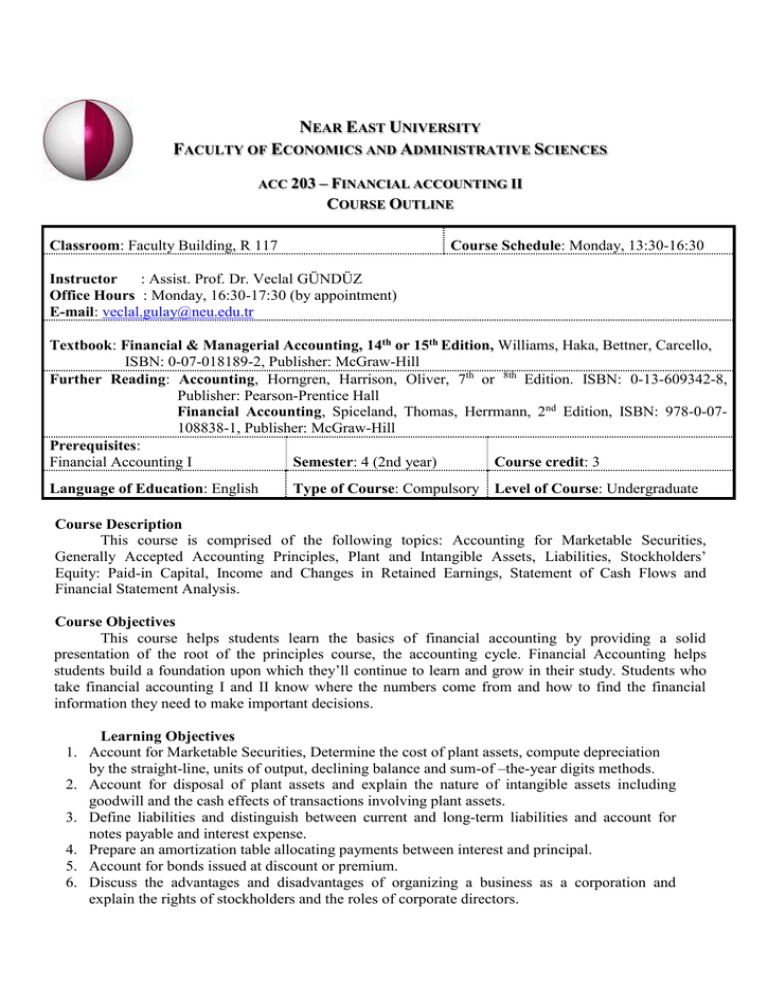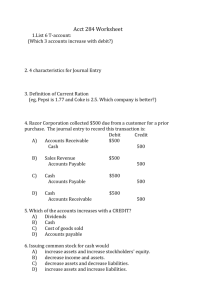
NEAR EAST UNIVERSITY
FACULTY OF ECONOMICS AND ADMINISTRATIVE SCIENCES
ACC 203 – FINANCIAL ACCOUNTING II
COURSE OUTLINE
Classroom: Faculty Building, R 117
Course Schedule: Monday, 13:30-16:30
Instructor
: Assist. Prof. Dr. Veclal GÜNDÜZ
Office Hours : Monday, 16:30-17:30 (by appointment)
E-mail: veclal.gulay@neu.edu.tr
Textbook: Financial & Managerial Accounting, 14th or 15th Edition, Williams, Haka, Bettner, Carcello,
ISBN: 0-07-018189-2, Publisher: McGraw-Hill
Further Reading: Accounting, Horngren, Harrison, Oliver, 7th or 8th Edition. ISBN: 0-13-609342-8,
Publisher: Pearson-Prentice Hall
Financial Accounting, Spiceland, Thomas, Herrmann, 2nd Edition, ISBN: 978-0-07108838-1, Publisher: McGraw-Hill
Prerequisites:
Financial Accounting I
Semester: 4 (2nd year)
Course credit: 3
Language of Education: English
Type of Course: Compulsory Level of Course: Undergraduate
Course Description
This course is comprised of the following topics: Accounting for Marketable Securities,
Generally Accepted Accounting Principles, Plant and Intangible Assets, Liabilities, Stockholders’
Equity: Paid-in Capital, Income and Changes in Retained Earnings, Statement of Cash Flows and
Financial Statement Analysis.
Course Objectives
This course helps students learn the basics of financial accounting by providing a solid
presentation of the root of the principles course, the accounting cycle. Financial Accounting helps
students build a foundation upon which they’ll continue to learn and grow in their study. Students who
take financial accounting I and II know where the numbers come from and how to find the financial
information they need to make important decisions.
1.
2.
3.
4.
5.
6.
Learning Objectives
Account for Marketable Securities, Determine the cost of plant assets, compute depreciation
by the straight-line, units of output, declining balance and sum-of –the-year digits methods.
Account for disposal of plant assets and explain the nature of intangible assets including
goodwill and the cash effects of transactions involving plant assets.
Define liabilities and distinguish between current and long-term liabilities and account for
notes payable and interest expense.
Prepare an amortization table allocating payments between interest and principal.
Account for bonds issued at discount or premium.
Discuss the advantages and disadvantages of organizing a business as a corporation and
explain the rights of stockholders and the roles of corporate directors.
7. Account for paid-in capital and prepare the equity section of a corporate balance sheet and
contrast the features of common stock with those of preferred stock.
8. Discuss the factors affecting the market price of preferred stock and common stock, and
explain the significance of par value, book value, and market value of capital stock.
9. Explain the purpose and effects of a stock split and accounting for treasury stock transactions.
10. Describe how discontinued operations, extraordinary items and accounting changes are
presented in the income statement.
11. Compute earnings per share, account for cash dividends and stock dividends and explain the
effects of these transactions on a company’s financial statements.
12. Describe and prepare statement of retained earnings and define prior period adjustments and
explain how they are presented in financial statements.
13. Describe and prepare the statement of stockholders’ equity
14. Explain the purpose and uses of statement of cash flows and describe how cash transactions
are classified in a statement of cash flows.
15. Compute the major cash flows relating to operating activities, investing activities and
financing activities.
16. Explain why net income differs from net cash flows from operating activities.
17. Explain the uses of dollar and percentage changes, trend percentages, component percentages
and ratios.
18. Discuss the quality of a company’s earnings, assets and working capital and explain the nature
and purpose of classifications in financial statements.
19. Prepare a classified balance sheet, multiple-step/single-step income statement and compute the
ratios widely used in financial statement analysis and explain the significance of each.
Learning Outcomes
Learning outcomes in this course include, understanding accounting for marketable
securities, being able to calculate depreciation for plant assets and reflecting it to the income
statement and balance sheet, understanding the accounting for disposal of plant assets, knowing
the liabilities including accounting for bonds payable, understanding the preparation and analysis
of stockholders’ equity section of the balance sheet, knowing how to prepare the statement of
retained earnings and statement of stockholders equity, understanding the preparation of the
statement of cash flows and being able to analyze financial statements from the viewpoints of
common stockholders, creditors and others.
Course Assessment
Grades in this course will be assigned according to the following criteria:
Mid-term Examination
:
30%
Final Exam
:
50%
Case Studies & Homework :
10%
Quiz & Attendance
:
10%
Total: 100%
Course Requirements and Policies
Participation in class discussions is stiffly encouraged and considered as potential bonus points.
Please make sure that you attend at least 70% of the courses.
Week
1
2
3
4
5
6
7
8
9
10
11
12
13
14
Chapter
6
6
8
8
9
9
6, 8, 9
10
10
11
11
13
13
Tentative Syllabus
Topic
Merchandising Activities
Merchandising Activities (exercises)
Inventories and COGS
Inventories and COGS (exercises)
Plant and Intangible Assets
Plant and Intangible Assets (exercises)
Revision
Mid Term Examination
Liabilities
Liabilities (exercises)
Stockholders’ Equity: Paid-In Capital
Stockholders’ Equity: Paid-In Capital (exercises)
Statement of Cash Flows
Statement of Cash Flows (exercises)
Final Examination
Guidelines For Assignments, Case Studies:
Specific
1. All assignments (homework) will be typed and printed on an A-4 paper and submitted in a
plastic folder file.
2. Leave a left margin on each page, wide enough for grading, and use one side of the page
only.
3. Each problem and its parts should be properly labeled, and should appear in same order as in
the assignment sheet. This is not necessary in the exams.
General
1. Homework should be clearly written on a white paper, with a cover page. They should be in
a form that would be acceptable to your future employer. Sloppy work will not be accepted.
2. Late assignments will not be accepted for initial credit unless you have an authorized written
excuse. Late assignments within acceptable dates will be graded with a 20% discount. No
homework can be accepted after the return of corrected homework.
3. Individual work must reflect an individual’s effort, Group work is expected to be the joint
work of the group, neither of an individual nor other outside the group. Do not copy from
others. Academic dishonesty carries a penalty that may range from receiving a grade of zero
to expulsion from the University. More on this is in school regulation.







